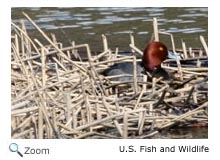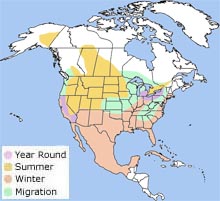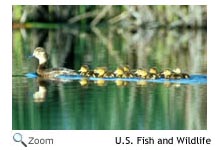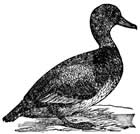Description
 The redhead is a diving duck that is 17-21 in length with a wingspan of 30-31 inches. It has a rounded head and a grayish-blue bill with a black tip. It has grayish-blue legs and feet and a gray stripe on its wings. The male has a copper colored head, a gray back, and a black breast and rump. The female is a grayish-brown on her back, sides, and wings. She has a lighter grayish-brown belly. The redhead is a diving duck that is 17-21 in length with a wingspan of 30-31 inches. It has a rounded head and a grayish-blue bill with a black tip. It has grayish-blue legs and feet and a gray stripe on its wings. The male has a copper colored head, a gray back, and a black breast and rump. The female is a grayish-brown on her back, sides, and wings. She has a lighter grayish-brown belly.
Range  The redhead breeds in central Alaska, the Great Plains, the Great Lakes, and in the some areas of the western U.S. and Canada. It winters in the southern U.S. and along the Atlantic and Pacific coasts south into Mexico. The redhead breeds in central Alaska, the Great Plains, the Great Lakes, and in the some areas of the western U.S. and Canada. It winters in the southern U.S. and along the Atlantic and Pacific coasts south into Mexico.
|
|
Habitat
The redhead
is found in
shallow freshwater lakes, ponds, marshlands, coastal waters, and bays.
Diet
The redhead is a diving duck. It
searches for aquatic vegetation in muddy shallow areas of water. It may also eat
mollusks, aquatic insects, and small fish
Life Cycle  Pairs form in the late winter or the early spring. The female lays 10-16 eggs in a cup-shaped nest lined with down and attached to reeds and other marsh vegetation. The male leaves the female once she begins to incubate the eggs. The eggs hatch in 25-26 days. The ducklings are precocial and can feed themselves shortly after hatching. The ducklings fledge when they are about two months old. The female sometimes lays her eggs in the nests of other ducks. Pairs form in the late winter or the early spring. The female lays 10-16 eggs in a cup-shaped nest lined with down and attached to reeds and other marsh vegetation. The male leaves the female once she begins to incubate the eggs. The eggs hatch in 25-26 days. The ducklings are precocial and can feed themselves shortly after hatching. The ducklings fledge when they are about two months old. The female sometimes lays her eggs in the nests of other ducks.
Behavior
Like most diving ducks, the redhead's legs are set back on its body to help it swim and dive. It is awkward on land, and it has to run across the water to take of in flight. The male has a meow-like call, and the female makes a squawking sound.
|



 The redhead breeds in central Alaska, the Great Plains, the Great Lakes, and in the some areas of the western U.S. and Canada. It winters in the southern U.S. and along the Atlantic and Pacific coasts south into Mexico.
The redhead breeds in central Alaska, the Great Plains, the Great Lakes, and in the some areas of the western U.S. and Canada. It winters in the southern U.S. and along the Atlantic and Pacific coasts south into Mexico.
